In May 1842, following a long and drawn out investigation, the Parliamentary report on “The Employment and Conditions of Children in Mines and Manufactories” was published.
The report made harrowing reading, confronting, as it did, the people of England with first hand reports of children as young as four, being sent to work in coal mines, mills and factories with little being done for their well being, welfare and education.
Worse still, was the picture the report painted of the moral conditions under which the children had to work, with girls being forced to work in cramped mine shafts alongside naked men.
The report was widely regarded as a wake up call concerning the degradation that so many young children were being forced to endure day in and day out.
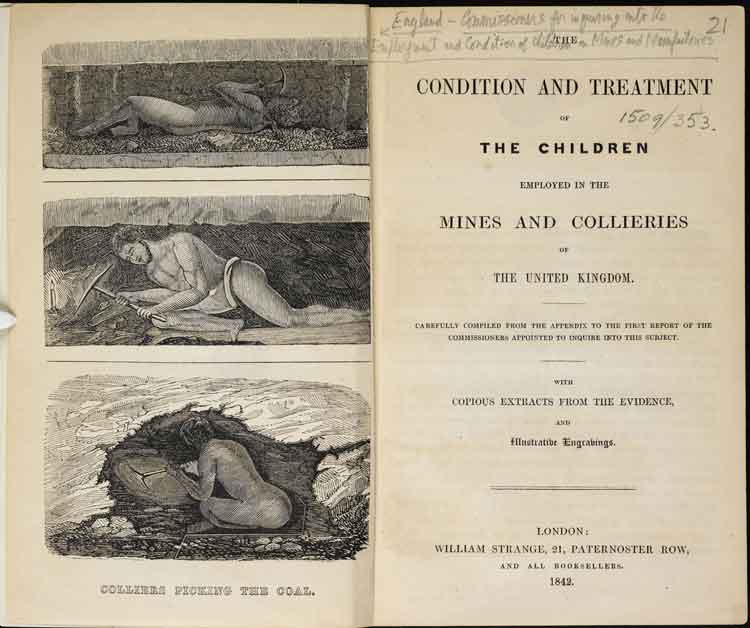
CHARLES DICKENS READS THE REPORT
Amongst those who read and were affected by the report was Charles Dickens who, in the October of 1842, gathered a group of equally outraged friends, and ventured into the mines to conduct an on the spot investigation.
He was furious at the sights he encountered, and he vowed that he would write a pamphlet which, he promised, would strike a hammer blow for the poor man’s child.
Ultimately, the pamphlet did not appear; because he decided, instead, to write a novella which, so he hoped, would have a wider reach and impact than a political pamphlet ever could.
INSPIRATION FOR A CHRISTMAS CAROL
The book that the report, in part at least, inspired was A Christmas Carol, published on the 19th of December 1843.
The book is still, without doubt, his best known and best loved work; whilst the Parliamentary report that started the whole thing rolling is hardly, if at all, remembered.
So, today, I thought it would be a nice tribute to the report – and, more importantly, to the forgotten children whose plights it highlighted – to bring you a newspaper article that featured some of the harrowing stories that appeared in the Parliamentary report.
The following summary appeared in the Morning Advertiser on the 7th of May 1842:-
CHILDREN EMPLOYED IN MINES
“We have just received the appendix to the first report of the Commissioners appointed to inquire into the employment of mines and factories, comprising upwards of 1,800 folio pages, and we purpose, as we can find time and place, to lay before our readers such abstracts of the evidence they contain as may give them a tolerably accurate notion of the nature of the employment, and of the physical and moral condition of large numbers of young children of both sexes, belonging to the poorer classes, inhabiting the mining and manufacturing districts of the United Kingdom.
The appendix, which we have now before us, relates to the mines, and contains the reports and evidence collected by the sub-commissioners in various districts of England, Scotland, and Wales.
Of the numbers of children employed in the iron, coal, tin, and lead mines, it is difficult, if not impossible, to form any very nice estimate; but they must be very large.
SENT TO WORK AT SIX AND SEVEN
In many pits they are sent to work at a very early age, some at six years, and at all ages after.
Some are apprenticed as early as eight or nine years of age.
Some few cases are mentioned where children have been set to work at the tender age of four years!
According to the evidence collected by Dr. Mitchell, the proportion of men to boys in the iron-stone pits of Staffordshire is 100 to 80; in the coal pits it is 100 to 30.
Many of the iron-stone pits are low, and there horses cannot be employed, which is the reason for there being so large a proportion of boys in competition with the men, to push the skips or carriages to the foot of the shaft.
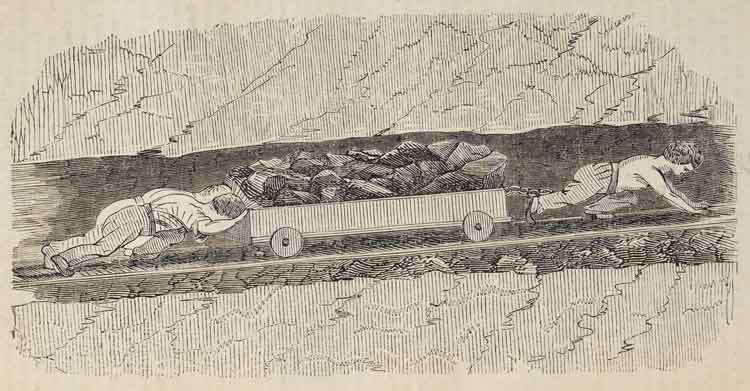
THE EMPLOYMENT OF FEMALE CHILDREN
In some of the mines the improper and reprehensible practice of employing female children to perform precisely the same description of labour as that performed by the boys prevails.
Mr. Symons, reporting upon the Yorkshire coal field, says, in one place:-
“It is my duty to direct your attention to the deplorable outrage of introducing females into collieries, which prevails at Silkstone and Flockton, but which I have reason to believe is peculiar to these and some neighbouring district.
I have here merely to remark that girls regularly perform all the various offices of trapping, hurrying, filling, riddling, topping and occasionally getting, just as they are performed by boys.

DISGUSTING AND INDECENT SIGHTS
One of the mot disgusting sights I have ever seen was that of young females, dressed like boys in trousers, crawling on all fours, with belts round their waists and chains passing between their legs, at day pits.
When I arrived at the board, or workings of the pit, I found at one of the side boards, down a narrow passage, a girl of 14 years of age, in boy’s clothes, picking down the coal with the regular pick used by the men. She was half sitting, half lying at her work, and said she found it tired her very much, and ‘of course, she didn’t like it.’ The place where she was at work was not two feet high.
Further on were men at work, lying on their sides, and getting.
No less than six girls, out of 18 men and children, are employed at this pit.
In two other pits in the Huddersfield Union, I have seen the same sight.
In one, near New Mills, the chain, passing high up between the legs of two of these girls, had worn large holes in their trousers, and any sight more disgustingly indecent or revolting can scarcely be imagined than these girls at work. No brothel can best it.
I took their evidence afterwards, when they were sent to me washed and dressed, and one of them, at least, was evidently crammed with her evidence.”
These two girls were, at the time spoken of, aged 14 and 13 respectively; they had been at work in the pit eight years, and the flippant manner in which the younger of the two gave her evidence, shows what effect her employment and associations have had upon her moral feelings.
She said:-
“There are other girls that hurry in the same way, with belt and chain. Our breeches are often torn between the legs with the chain. The other girls’ breeches are torn as often as ours; they are torn many a time, and when they are going along we can see them all between the legs, naked. I have often; and that girl, Mary Holmes, was so today; she denies it, but it’s true, for all that”
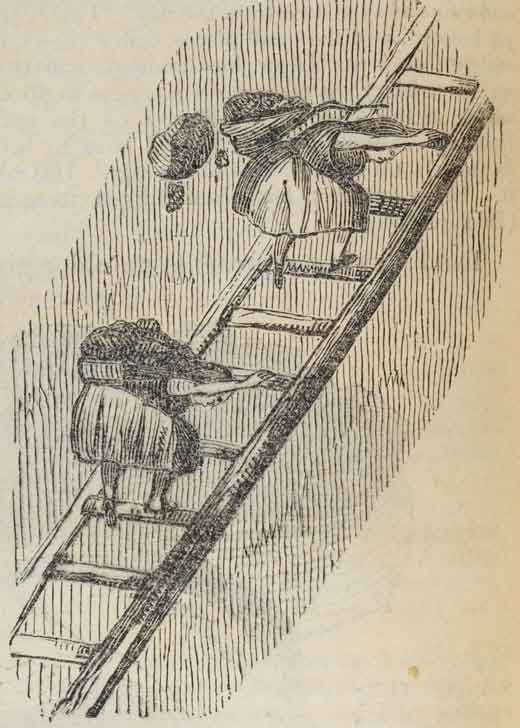
FLAGRANTLY DISGRACEFUL
Before we quit this painful part of the subject, we must refer to another part of Mr. Symons’s report, from which the following is an extract:-
“The practice of employing females in coal pits is flagrantly disgraceful to a Christian, as well as to a civilised, country.
On descending Messers. Hopwood’s pit at Barnsley, I found assembled round the fire a group of men, boys, and girls, some of whom were of the age of Puberty, the girls, as well as the boys, stark naked down to their waists; their hair bound up with a tight cap, and trousers supported by their hips. Their sex was recognisable only by their breasts. and some little difficulty occasionally arose in pointing out to me which were girls and which were boys, which caused a good deal of laughing and joking. Five of these girls came well dressed in the evening to be examined.
MEN WORK STARK NAKED
In the Flockton and Thornhill pits the system is even more indecent; for though the girls are clothed, at least three-fourths of the men for whom they hurry, work stark naked, or with a flannel waistcoat only and in this state they assist one another to fill the corves 18 or 20 times a day. I have seen this done myself, not once or twice, but frequently.
Neither do the girls or the men attempt to gainsay the fact.
When it is remembered that these girls hurry chiefly for men who are not their parents, that they go from 15 to 20 times a day into a dark chamber, which is often 30 yards apart from any one, to a man working naked, or next to naked, it is not to he supposed but that where opportunity thus prevails sexual vices are of common occurrence.”
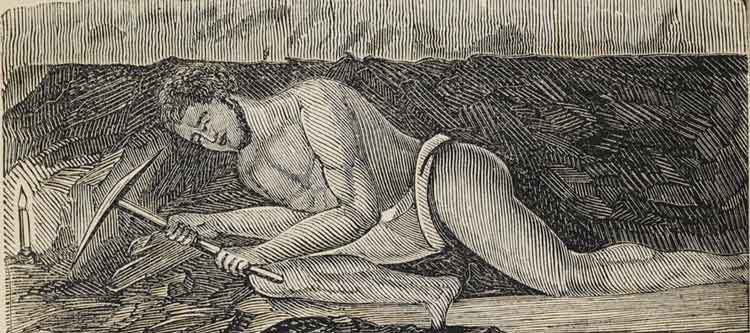
JOHN THORNLEY’S EVIDENCE
The evidence given by several of the witnesses fully bears out Mr. Symons’s opinion of the frightfully immoral tendencies of this disgusting practice.
John Thornley, Esq., one of Her Majesty’s Justices of the Peace for the county of York, who states that he has had 40 years’ experience in the management of collieries, says:-
“The system of having females to work in coal-pits prevails generally in this neighbourhood. I consider it to be a most awfully demoralising practice. The youths of both sexes work often in a half-naked state, and the passions are excited before they arrive at puberty. Sexual intercourse decidedly frequently occurs in consequence. Cases of bastardy frequently occur also; and I am decidedly of the opinion that women brought up in this way lay aside all modesty, and scarcely know what it is but by name.”
MATTHEW LINDLEY’S EVIDENCE
Matthew Lindley, a Yorkshire collier, 52 years of age, says :—
“I wish that the Government would expel all girls and females from mines.
I can give proof that they are very immoral, and I am certain that the girls are worse than the men in point of morals, and use far more indecent language.
It unbecomes them in every way. I have known myself of a case where a married man and a girl who hurried for him had sexual intercourse, often in the bank where he worked.”
JOHN SIMPKIN’S SHOCKING EVIDENCE
And another collier, named John Simpkin, aged 40, says:-
“I have worked a good deal where girls were employed in the pits. I have had children by them myself; I have frequently had connexion with them in the pits. I am sure that this is the case, especially in the pits about Lancashire.”
These extracts are chiefly made from Mr. Symons’s report; but other of the assistant Commissioners report similarly.
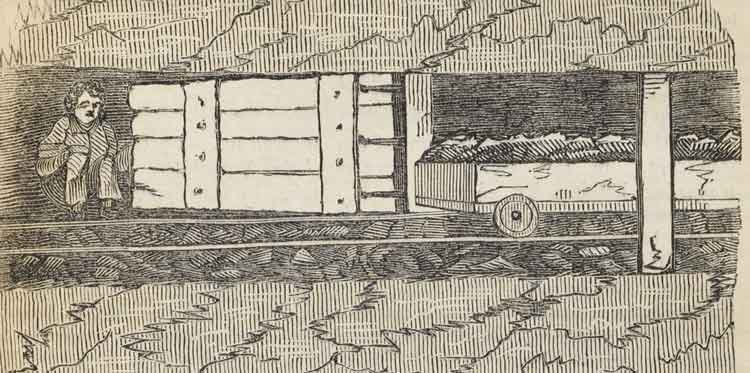
MR SCRIVEN’S REPORT
Mr. Scriven in his report from the West Riding, says:-
“Girls, from five to eighteen, perform all the work of boys. There is no distinction whatever in their coming up the shafts or going down – in the mode of hurrying or thrusting – in the weights of corves, or in the distances they are hurried – in wages or dress.
They are to be found alike vulgar in manner and obscene in language; but who can feel surprise at their debased condition, when they are known to be constantly associated, and associated only, with men and boys living and labouring in a state of disgusting nakedness and brutality, while they have themselves no other garment than a ragged shift, or, in the absence of that, a pair of broken trousers, to cover their persons.”
EVIDENCE FROM THE CHILDREN THEMSELVES
Amongst the witnesses who gave their evidence before this Gentleman were several of these wretched children.
Their condition may be judged of by an extract or two.
Patience Hershaw says:-
“I wear a belt and chain at the workings to get the carves out. The getters are naked, except their caps; they pull off all of their clothes. I see them at work when I go up.
The boys take liberties with me sometimes; they pull me about. I am the only girl in the pit. There are 20 boys and 15 men. All the men are naked. I would rather work in the mill than in the coal pit.”
Ruth Barnett says:-
“I come down into pits in linings of old trousers, which I take off. I wear an old waistcoat and shift. I do not like working in the pit; I would not do it if I could help it.”
Mary Barnett says:-
“I do not like working in the pit, but I am obliged to get a living. I work without stockings, or shoes, or trousers; I wear nothing but my shift.”
FRIGHTFULLY DEMORALISING
We might multiply evidences of the frightfully demoralising effects of this disgusting practice; but it is unnecessary; we have given enough.
Mr. Franks, in his report of the condition of the children employed in the mines in the Lothian and River Forth districts of Scotland, states that the employment of females in his description of labour there is generally considered to he so degrading, that “other classes of operatives refuse intermarriage with the daughters of colliers who are wrought in the pits.”
A RACE FALLEN FROM THE COMMON STOCK
Mr. Scriven, in his Report of the West Riding, says:-
“I have often been Shocked in contemplating the hideous, and anything but human, appearance of these men, who are generally found in a state of bestial nakedness, lying their whole length along the uneven floor, and supporting their heads upon a board or short crutch, or sitting upon one heel, balancing their persons by extending the other.
Black and filthy as they are in their low, dark, heated, and dismal chambers, they look like a race fallen from the common stock.”
A CHRISTMAS CAROL
The report makes harrowing reading, even today, separated as we are by the passage of more than 175 years.
So, it doesn’t take much imagination to picture the effect it had on people like Charles Dickens, reading it for the first time and knowing that the conditions being spoken of were, not just a part of the society in which they lived, but were instrumental in providing the very fuel that was powering, heating and fuelling that society.
A DISTURBING PASSAGE
Indeed, the conditions described in the report provided the inspiration for one of the most memorable, and disturbing passages, in A Christmas Carol, which occurs as the waning spirit of Christmas Present prepares to leave Scrooge.

IGNORANCE AND WANT
“‘Forgive me if I am not justified in what I ask,’ said Scrooge, looking intently at the Spirit’s robe,’but I see something strange, and not belonging to yourself, protruding from your skirts. Is it a foot or a claw?’
‘It might be a claw, for the flesh there is upon it,’ was the Spirit’s sorrowful reply. ‘Look here.’
From the foldings of its robe, it brought two children; wretched, abject, frightful, hideous, miserable. They knelt down at its feet, and clung upon the outside of its garment.
‘Oh, Man! look here. Look, look, down here!’ exclaimed the Ghost.
They were a boy and a girl. Yellow, meagre, ragged, scowling, wolfish; but prostrate, too, in their humility. Where graceful youth should have filled their features out, and touched them with its freshest tints, a stale and shrivelled hand, like that of age, had pinched, and twisted them, and pulled them into shreds. Where angels might have sat enthroned, devils lurked, and glared out menacing. No change, no degradation, no perversion of humanity, in any grade, through all the mysteries of wonderful creation, has monsters half so horrible and dread.
Scrooge started back, appalled. Having them shown to him in this way, he tried to say they were fine children, but the words choked themselves, rather than be parties to a lie of such enormous magnitude.
‘Spirit, are they yours.’ Scrooge could say no more.
‘They are Man’s,’ said the Spirit, looking down upon them.
‘And they cling to me, appealing from their fathers.
This boy is Ignorance. This girl is Want. Beware them both, and all of their degree, but most of all beware this boy, for on his brow I see that written which is Doom, unless the writing be erased. Deny it.’ cried the Spirit, stretching out its hand towards the city. ‘Slander those who tell it ye! Admit it for your factious purposes, and make it worse. And abide the end.’
‘Have they no refuge or resource.’ cried Scrooge.
‘Are there no prisons.’ said the Spirit, turning on him for the last time with his own words. ‘Are there no workhouses.'”
